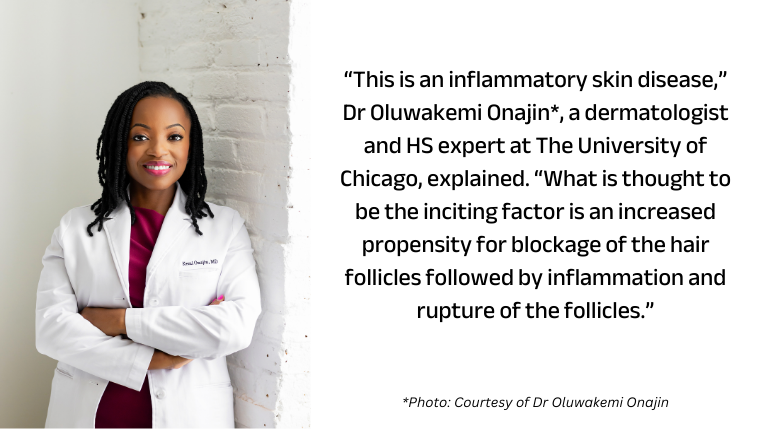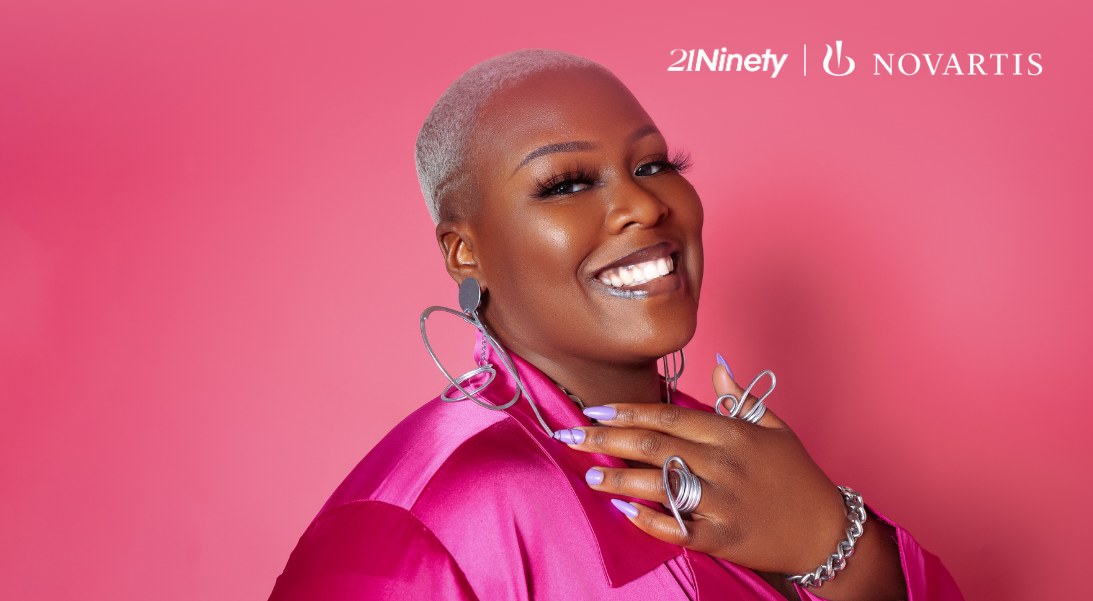While many of us recall middle school as a time for exciting new adventures and self-growth, Jasmine IVANNA Espy* was beginning her journey with a chronic skin condition that would forever change her relationship with her own body.
“I had severe HS,” Jasmine, a now confident and proud advocate for others living with hidradenitis suppurativa, recalled. “While my peers were out there experiencing what teenagers experience, I was cleaning pus and blood off my body and waddling because I had a boil-like abscess in between my legs.”
HS is a chronic and often painful skin disease that causes recurring boil-like abscesses that may burst into open wounds and cause irreversible scarring. The boil-like lumps or abscesses caused by HS can appear anywhere on the body, but are commonly on intimate areas where skin meets skin, such as the groin, inner thighs, buttocks, under the breasts, and the armpits. These lumps can then burst, leak and leave scars.

The contents released from the ruptured follicle and bacteria in the skin further trigger an “inflammatory cascade” of more inflammation which eventually leads to formation of tunnels and scarring.
“I had never experienced something that would disrupt my life like HS did,” Jasmine recalled.
For years, Jasmine had no idea what was causing the painful abscesses on her body, as she received one misdiagnosis after another.
Years of misdiagnosis are an unfortunate reality for many people living with HS, especially for patients of color. On average, it takes people up to ten years and seeing as many as ten doctors for their symptoms before getting their HS diagnosis.
Dr Onajin noted a recent increase in HS research over the past five to ten years with increasing awareness of the disease, but shared that it’s a slow process to get this information out to everyone who needs it.
But the same information that can move slowly through medical communities, can go viral on social media in a matter of minutes – making it the perfect resource for HS advocates like Jasmine.
Jasmine uses her background as a journalist and filmmaker to empower the HS community on social media and beyond. She is also the host and consulting-producer of a groundbreaking docuseries called, “The Beacons: Illuminating HS Stories.” The series is part of a multiyear disease education campaign led by Novartis called Shine a Light on HS.
By sharing her own journey and the information she’s learned along the way, such as what HS symptoms look like on skin of color, Jasmine’s work has the potential to combat the racial disparities that exist in HS care and treatment. When people of color can better identify and understand the symptoms they’re experiencing, it could encourage them to consult a physician much sooner.
“Some of my patients are more likely to go to the emergency room and less likely to have a primary care physician or dermatologist that they see regularly,” Dr Onajin explained. “Those with more severe HS are more likely to be hospitalized instead of going to a dermatologist. So, these patients tend to go much longer before they receive a diagnosis and consequently often have more severe disease.”
Delaying proper diagnosis and treatment can potentially allow HS symptoms to become worse and the effects of a disease like this go much deeper than the skin.
“HS is associated with an increased risk of anxiety and depression,” Dr Onajin added. “Patients have difficulty maintaining relationships and jobs. It’s really a debilitating condition.”
At the suggestion of her physician, Jasmine began going to therapy and adopted the practice of mirror work to help improve her mental health. This practice involved Jasmine spending intentional time in the mirror observing every part of her body, including her abscesses and scars, without any judgment.
“Mirror work was a grounding practice,” Jasmine explained. “It allowed me to really sit with my diagnosis and sit with the emotions and the trauma I had experienced around my journey with HS.”
This self-healing practice not only improved Jasmine’s mental health, but it empowered her to step into the work that has helped so many others with similar stories.
“[My physician] told me, ‘One day you might be in a space where you can tell your story and you can help other people just like you,’” Jasmine recalled. “‘But the first step you have to do is own your story, own your trauma, and heal what you’re going through.’”
Jasmine added that therapy and mirror work have helped her unpack her experience so she could clearly and concisely communicate what she’s gone through and the journey that lies ahead.
People with HS are more likely to have certain diseases that go beyond the skin and often need a multidisciplinary care team. For those living with HS, Dr Onajin stresses the importance of seeing a dermatologist and regular checkups with a primary care physician. She also hopes that friends and families of people living with HS will understand that they play a critical role in the healing journey.
“Be patient with your loved one who’s going through this,” Dr Onajin said. “They’re going to have times where they won’t seem like themselves, especially when they’re going through a flare.”
She noted that the first visit after an HS diagnosis comes with a lot of information that can feel overwhelming for someone who’s alone. Having loved ones around can help patients better understand and recall the information being given to them.
“For patients that have more severe disease, they’re going to have extensive scarring,” Dr Onajin explained. “The tunnels are still going to be there. Our initial goal is to decrease the pain, the draining, the swelling, the odor and all of the symptoms that are associated with inflammation.”
Jasmine continues to be a bold, beautiful advocate for others living with this skin condition. She hopes that others living with HS will understand that one diagnosis doesn’t have to define the rest of their life.
“There is life on the other side of having a diagnosis like this,” Jasmine said. “It does take time and it’s not linear. It’s not something that’s going to happen overnight, but life is possible with HS.”
You can learn more about her impactful work and catch a glimpse into the journeys of six individuals who are living with HS at ShineALightOnHS.com.
*Jasmine IVANNA Espy and Dr Oluwakemi Onajin have been compensated for their time on this article. Jasmine IVANNA Espy is a paid consultant for other Novartis projects.
5/24 430524
